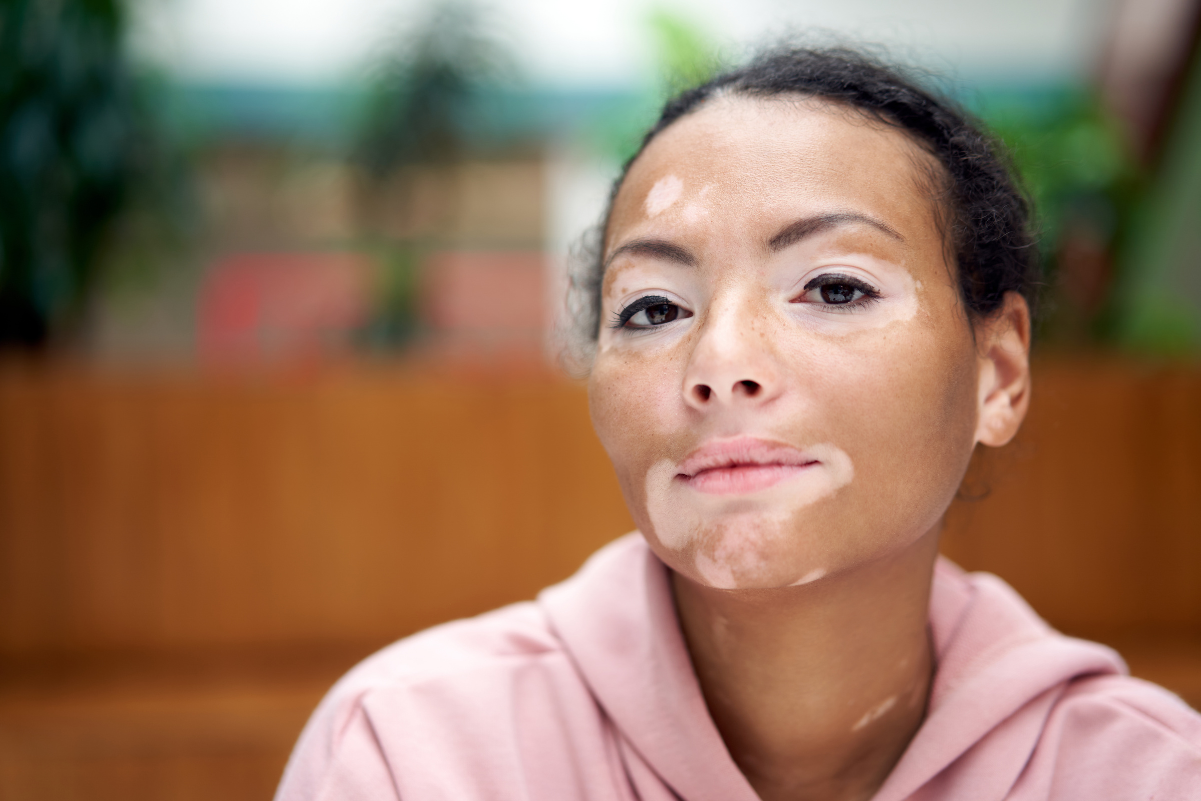Vitiligo is a relatively rare but often diagnosed and treated skin condition in the dermatology field. Here’s some helpful information to help better understand what vitiligo is and what treatment options are available!
1. Vitiligo is an autoimmune condition
This means that the immune cells in the body are attacking the pigment-producing cells in the skin, leading to the formation of flat, well-defined white patches. Sometimes the hair in those patches can also turn white. Vitiligo can sometimes also be seen with other autoimmune diseases, like thyroid disease, alopecia areata, diabetes, and several others.
2. Vitiligo has an unpredictable course
After vitiligo shows up, it may remain in the area where it started, or it may spread to involve a larger area. There is no way to predict if vitiligo patches will spread or not.
3. Vitiligo happens in all skin colors
Despite what some may think, vitiligo is not more common in individuals with skin of color. That being said, the contrast between affected skin and unaffected skin is more obvious, and potentially more cosmetically bothersome, in people with darker skin color. Vitiligo can affect people of any ethnicity at any age, though it usually begins between ages 2 and 40.
4. Vitiligo can show up more commonly in certain areas of the body
Vitiligo is common on the fingers, knuckles, elbows, face, upper chest, hands, armpits, and/or groin. Areas that may get injured or rubbed more frequently can have a higher risk of developing vitiligo.
5. Sun protection is very important for people with vitiligo
People with vitiligo can be high-risk for sun damage. For that reason, it’s important prioritize sun protection by avoiding peak sunlight hours (10 AM-3 PM), wearing a broad spectrum SPF 30 or higher sunscreen, ideally with zinc oxide 5% or higher, and wearing sun protective clothing like brimmed hats, sunglasses, long sleeves, and long pants.
6. Vitiligo treatment is optional
It is not required to treat vitiligo if it is not bothering you. Reasons to book an appointment with a dermatology provider would be if it is new, progressing, or becoming cosmetically bothersome. TreatmentThere are camouflage makeups that can help hide white patches if cosmetically desired.
7. Vitiligo treatment can be tricky and takes a long time
Under the supervision of a dermatology provider, there are several treatment options that may be effective for treating vitiligo. It’s important to have realistic expectations going into it. Most vitiligo medications take 6 months of consistent use to make a difference in vitiligo. There are no overnight solutions. Certain areas of the body tend to respond more easily to treatment, like the face, neck, and upper chest. The hands, feet, fingers, and toes are notoriously difficult to treat and almost never repigment. Your dermatology provider may try one or more of the following treatment options:
-
-
Steroid creams or ointments to help restore skin color. These need to be used only as directed by your dermatology provider to prevent the risk of atrophy or skin discoloration from overuse.
-
Nonsteroidal topical creams or ointments can be a helpful long-term option to help restore skin color. Several examples are tacrolimus (Protopic) ointment, pimecrolimus (Elidel) cream, and ruxolitinib (Opzelura) cream.
-
Narrow band ultraviolet B light therapy or laser performed in a dermatology office 2-3 times per week (average of 30 or more sessions) can be very helpful, especially when paired with topical therapies, to help repigment the skin. XTRAC narrow band ultraviolet B treatment is offered at North Metro Dermatology and works best for vitiligo on the face, neck, and upper chest. The hands, feet, fingers, and toes do not tend to respond as well as other areas of the body to ultraviolet B phototherapy.
-
In really severe, specific cases, highly specialized dermatology providers may recommend more drastic measures like skin grafts in harder to treat areas or topical chemical treatments for widespread vitiligo to depigment the remainder of normal skin for a more uniform look.
-
If you suspect you may have vitiligo, want to treat your vitiligo, or have any other new skin concerns, schedule an appointment with one of our dermatology providers. We’d be happy to help!





